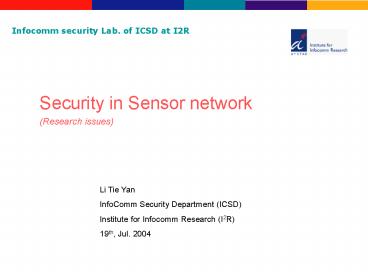Li Tie Yan - PowerPoint PPT Presentation
1 / 10
Title:
Li Tie Yan
Description:
Goal: Point-to-Point authentication and encryption not relying on hardware. ... Attacks: TinyOS Bless protocols (suffer Bogus routing information, selective ... – PowerPoint PPT presentation
Number of Views:22
Avg rating:3.0/5.0
Title: Li Tie Yan
1
Infocomm security Lab. of ICSD at I2R
Security in Sensor network (Research issues)
Li Tie Yan InfoComm Security Department
(ICSD) Institute for Infocomm Research
(I2R) 19th, Jul. 2004
2
Outline
- Sensor constraints
- Security map of sensor network
- Research issues
- Light weight crypto-algorithms
- Security (attacks) analysis on distributed
sensor network - Key management schemes for distributed
sensor network - Other issues
- Secure location (context aware security)
- Secure data fusion (secure information
aggregation) - Challenges
3
Sensor constraints
- Light weight crypto-algorithms
- Goal Point-to-Point authentication and
encryption not relying on hardware. - Constraint Based on TinyOS of Berkeley Mote
(Mica Motes feature a 4MHz processor, 128K of
program space 4k RAM, 36 byte packets, and
run on 2 AA batteries). - Light-weight Less overhead per packet
(conventionally, the overhead is 16 byte). - Assumption Keys are pre-distributed and shared
by sensors (simplest solution). - Analysis Cryptanalysis, attack analysis
- Attacks TinyOS Bless protocols (suffer Bogus
routing information, selective forwarding,
sinkholes, Sybil, wormholes, HELLO floods)
- Related works
- 802.15.4, New standard supported by ChipCon 2240
(Zigbee). - TinySec, Link layer encryption mechanism of U.C.
Berkeley
4
Security map
5
Security map
6
TinySec related researches
- TinySec related approaches
- TinyPK Authentication and DH key exchange
(BBN). - TinyCrypt ECC key exchange (Harvard Univ.)
- Light-weight key management Key exchange,
group management, key revocation (SRI). - Securesense Dynamic security service
composition (UMASS). - PKC Public key crypto in sensor. (WPI)
- SenSec (I2R)
- Others Many efforts in Industry
7
Research issues
- Attacks on sensor networks
- Denial of Service, by Wood et al. in IEEE
Computer2002. - Routing security, by Karlof et al. in 1st IEEE
workshop SNPA03. - Sybil attack, by Newsome et al. in ACM IPSN04.
- Key management schemes
- Key management, by Eschenauer et al. in ACM
CCS02. - SPINS, by Perrig et al. in Wireless Networks
Journal (WINE), 2002. - Random Key Assignment, by pietro et al. in ACM
SASN '03. - Establishing Pairwise Keys, by Liu et al. in ACM
CCS03. - LEAP, by Zhu et al. in proc. of ACM CCS03.
- Pairwise Key Pre-distribution, by Du et al. in
ACM CCS03. - Random Key Predistribution, by Chan et al. in
IEEE SP03 - Deployment knowledge, by Du et al. in IEEE
INFOCOM'04.
8
Other issues
- Location aware security (a problem of context
aware security) - Privacy-Aware Location, Gruteser et al. in
USENIX HOTOS IX, 2003. - Location-Based Pairwise Key Establishments, Liu
et al. in ACM SASN '03. - Location claims, by Sastry et al. in ACM
WiSe03. - Data fusion security (a problem known as False
data injection) - SIA, by Przydatek et al. in proc. of ACM
SenSys03. - Secure aggregation, by Hu et al. in workshop on
security and assureance in Ad hoc Networks, 2003.
- Witeness, by Du et al. in proc. of IEEE
GLOBECOM03. - SEF, by Ye et al. in proc. of IEEE INFOCOM04.
- Integrity protection, by Vogt et al. in
technical report no. 434, ETH Zrich. - IHA, by Zhu et al. in proc. of IEEE SP04.
- uTESLA, by Perrig et al. in proc. of ACM
Mobicom01. - LEAP, by Zhu et al. in proc. of ACM CCS03.
Authentication based
9
Challenges
- Software only cryptography (best balance of
security and performance, PKC) - Efficient key management (support random key
pre-distribution, PKC) - Robust multi-hop routing protocols (against node
compromise DoS attacks) - Location aware security (or context aware
security) - Secure and resilient aggregation (towards False
data injection) - Secure data centric storage (secure indexing,
secure overlay)
10
Collaboration
http//www.i2r.a-star.edu.sg/icsd/SecureSensor/
Key management, Calling for
Collaboration on PKC, Location
aggregation If you have passion on designing
symmetric/asymmetric crypto/security mechanisms
for wireless/constrained devices, lets do sth.
Interesting!
Thank you! Q A































